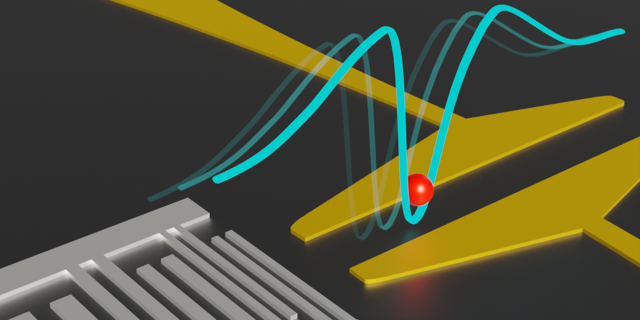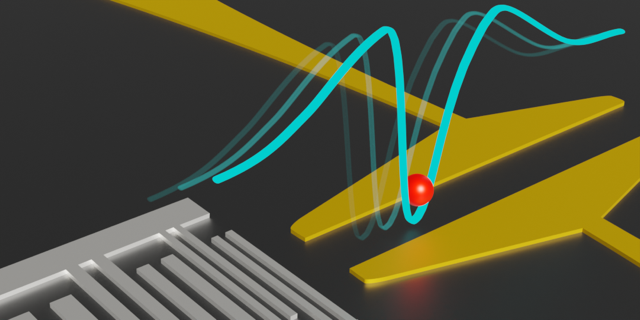Sound Pulse Drives Single-Electron Current
Circuits that transport single electrons one at a time could send quantum information between nodes of a quantum computer, but researchers have struggled with controlling the electron motion precisely enough. Now physicists have demonstrated improved control of single-electron transport using a focused sound wave, which carries the particle along a chip surface much as a water wave propels a surfer [1]. With further development, the researchers expect that the technique should be useful for engineering complex circuits in quantum computers or for controlling precision devices, such as single-photon sources.
Previous efforts to transport electrons with sound waves have employed so-called surface acoustic waves, which can travel along the surface of any solid. “Sound waves offer a powerful way to transport a single electron in nanoscale devices, but it’s been difficult to gain precise control because sound waves typically consist of many periods,” says Christopher Bäuerle of the Grenoble Alpes University in France. An extended, multicycle wave—as used in previous experiments—has many crests where an electron surfer can catch a ride, so the electron’s position over time is uncertain.
Now a team led by Bäuerle has developed a method that uses an intense, localized sound pulse rather than an extended wave. Bäuerle compares the focused pulses to tidal bores—small tidal waves that often travel upstream in rivers and carry objects along with them. As he and his colleagues show, “acoustic tidal bores” can accurately control the transport of an electron over long distances.
To test the principle, the researchers fabricated an electronic chip in a piezoelectric material, for which applied voltages naturally generate pressure differences. The left side of the chip consisted of a series of electrodes specially designed to electrically excite surface acoustic waves of short duration. These pulses were directed toward the right side of the chip, where they traversed a path with two quantum dots—semiconducting structures able to trap and hold single electrons. The dots were placed 8 micrometers apart and connected by a narrow conducting channel called a quantum rail.
The team loaded a single electron into the first quantum dot and then sent a sound pulse down the path. The traveling sound pulse carried with it a voltage pulse because of the piezoelectric nature of the material. In reality, it was this voltage pulse—induced by the sound wave—that captured the electron from the first quantum dot and transported it over to the second one.
In a series of some 70,000 experimental runs, the team demonstrated that the technique moved an electron between the two quantum dots with a success rate of more than 99%. More importantly, the focused wave gave greater control over placement of the electron. Grenoble Alpes team member Junliang Wang explains that previous experiments used waves with around 100 periods. “This means there are 100 possible locations to trap the electron.” By generating a single-period wave, he and his colleagues obtained a 100-fold improvement in controlling the electron’s location and arrival time.
With further development, Bäuerle suggests, this technique should offer a flexible means to precisely control the movement of electrons in circuits that process information using the electron charge or spin. Moreover, a single acoustic pulse might transport multiple electrons at different moments as it travels through an extended circuit, making this technique useful for constructing and operating much more complicated circuitry.
“This is really nice work,” says nanosystems physicist Hubert Krenner of the University of Münster in Germany. “Surface acoustic waves are excellent tools to control many kinds of quantum systems, including electrons. This work reaches a remarkable level of precision in creating single-cycle waves.” He expects the technique will be particularly useful for sources of single photons, where the sound waves can be used to precisely trigger the photon emission.
–Mark Buchanan
Mark Buchanan is a freelance science writer who splits his time between Abergavenny, UK, and Notre Dame de Courson, France.
References
- J. Wang et al., “Generation of a single-cycle acoustic pulse: A scalable solution for transport in single-electron circuits,” Phys. Rev. X 12, 031035 (2022).






